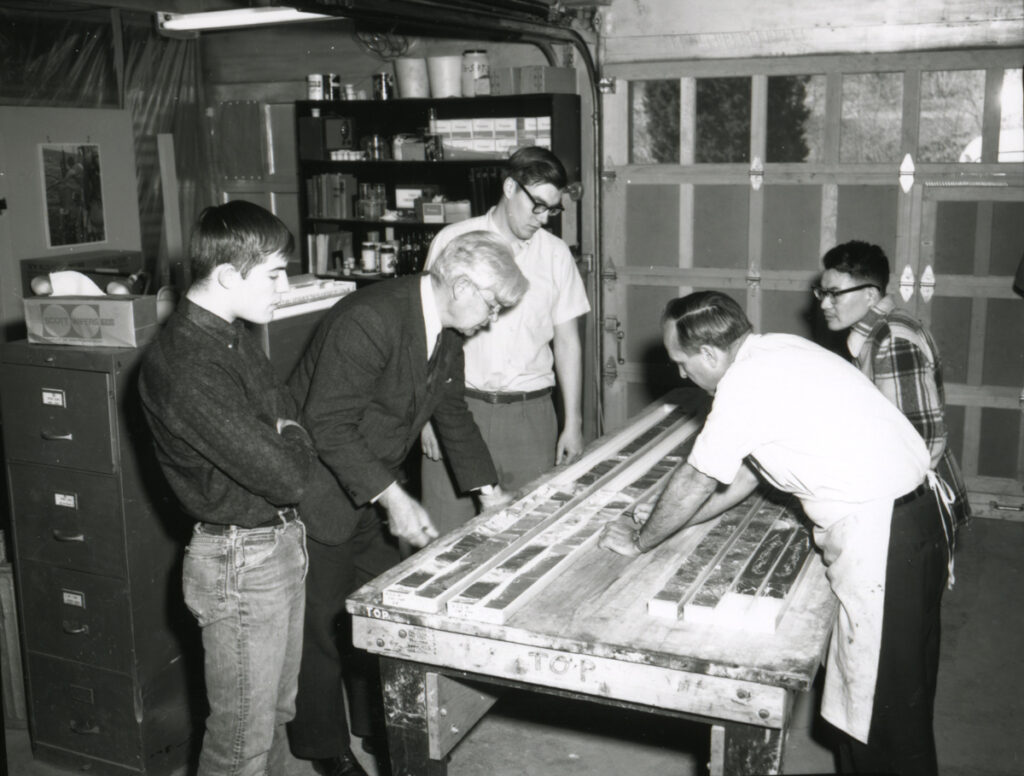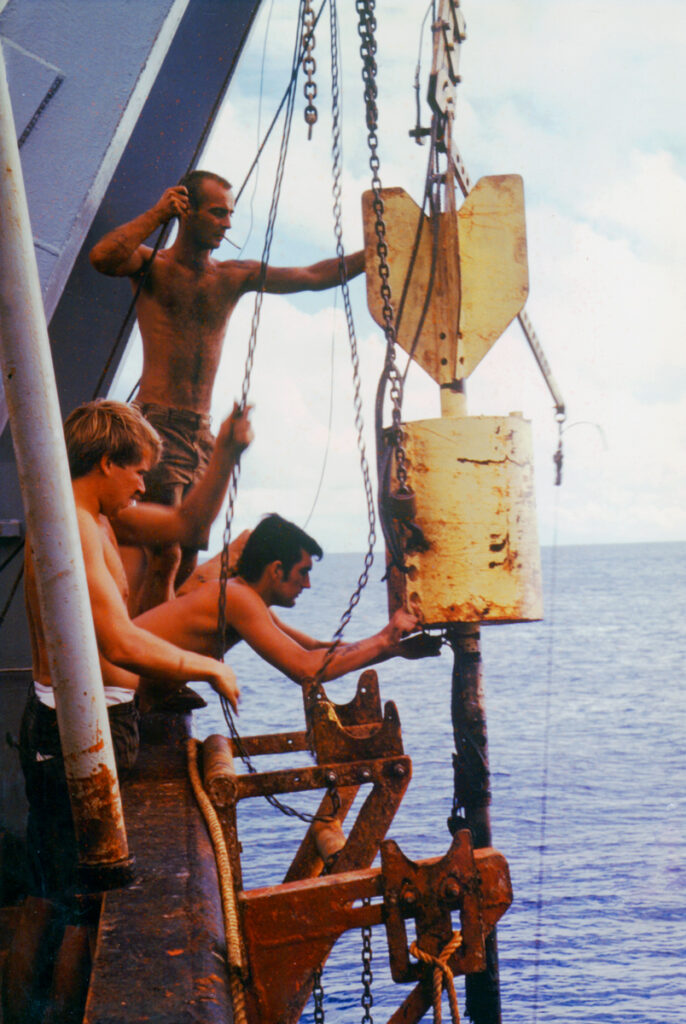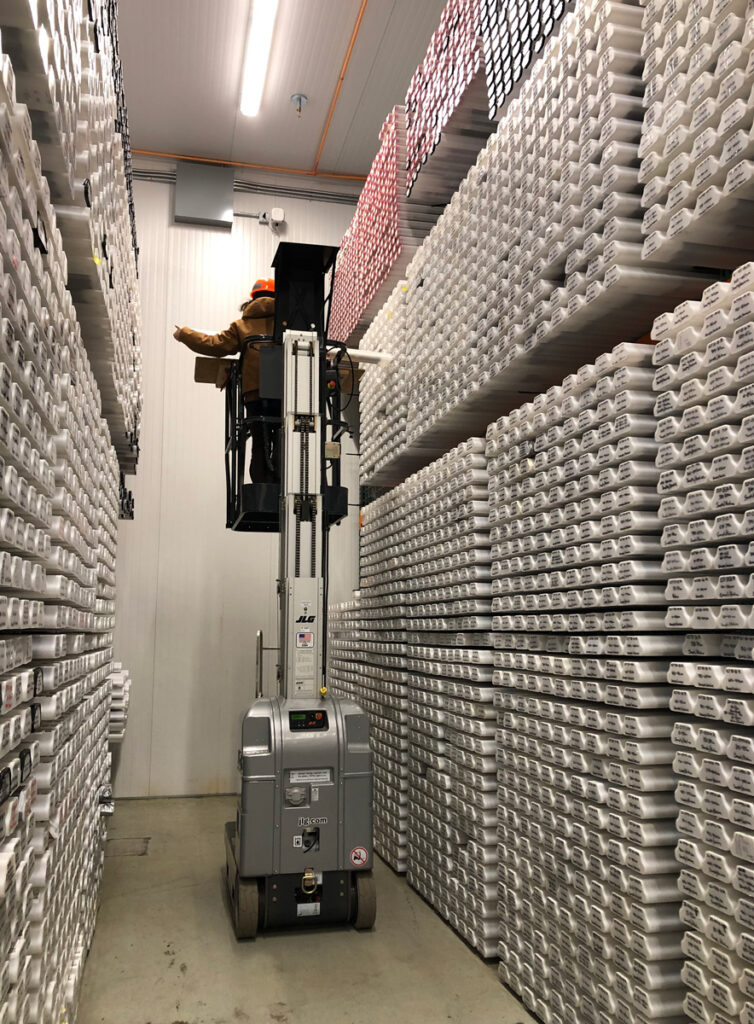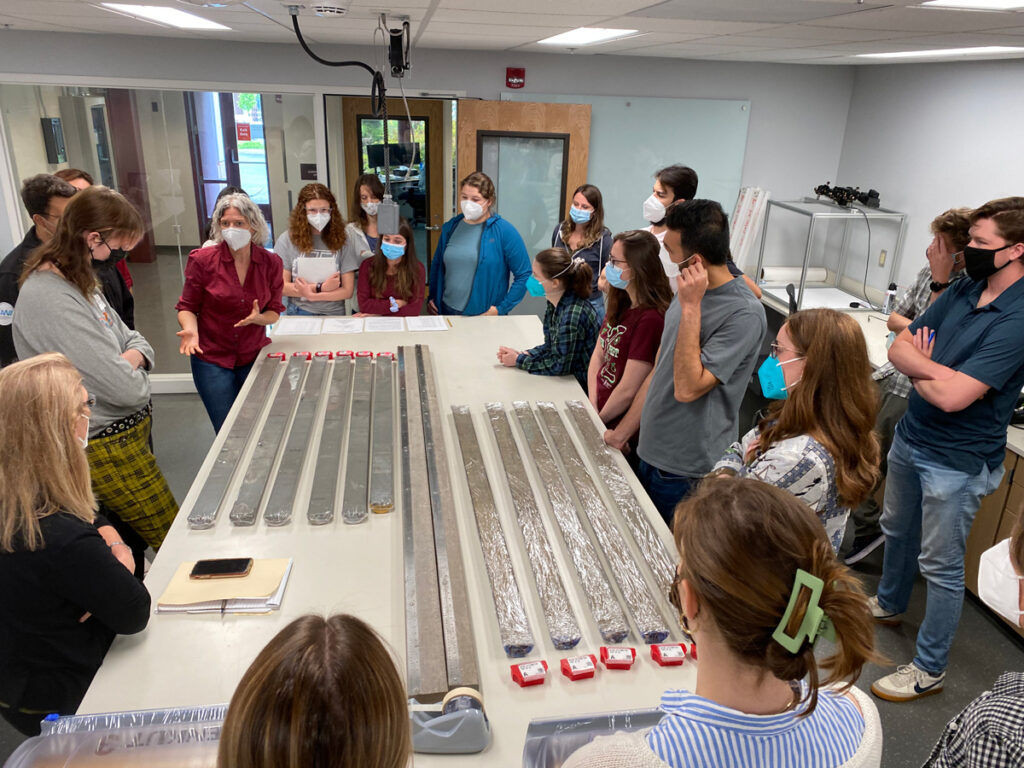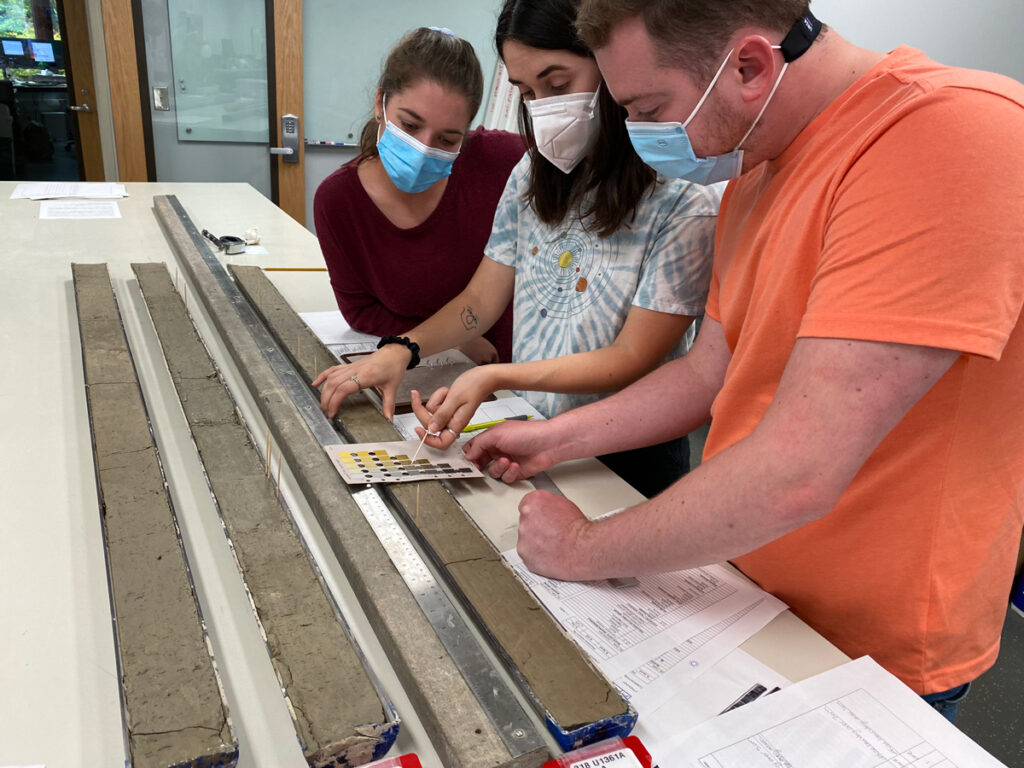Inside a squat, unassuming warehouse on the Narragansett Bay campus of the University of Rhode Island (URI), 4-meter-tall shelves are crowded with several thousand rocks hauled up from the seafloor. At the back of the building, a refrigerated room stores row upon row of 1.5-meter-long sediment cores pulled from depths of up to 8 kilometers below sea level.
Curators at the Marine Geological Samples Laboratory (MGSL) at URI liken the building to the Room of Requirement of Harry Potter fame or to an eccentric uncle’s overstuffed attic. In reality, it’s here where vital clues to the history of Earth’s climate, plate tectonics, hydrothermal vents, and sea life are stored. In fact, nearly all of our knowledge of plate tectonics and ice ages stems from such samples.
As the COVID-19 pandemic evolved, the marine geological sample repositories’ importance was underscored as many research cruises faced postponement or cancelation.
MGSL is one of four marine geological sample repositories funded by the National Science Foundation (NSF) that house unique collections of marine sediments and rocks. As the COVID-19 pandemic evolved, the repositories’ importance was underscored as many research cruises faced postponement or cancelation. Blocked from the open ocean, researchers turned to these collections to complete or continue their studies. At several repositories, curators saw large increases in requests for existing samples early in the pandemic, as part of postpandemic surges, or both.
The repositories have operated largely out of the public, and indeed the academic, eye for most of their existence. But with the experiences of the pandemic, and with a desire to ensure the preservation and discoverability of samples old and new, curators at these repositories—including us—are working to modernize their operation and share the repositories’ wealth of resources and accumulated knowledge further within and beyond the research community.
Mud Libraries
The four NSF repositories—one on the West Coast and three in the Northeast—share a joint purpose to preserve and provide access to marine geological samples, although they arose independent of one another. The Marine and Geology Repository at Oregon State University (OSU) came about with the start of the International Decade of Ocean Exploration in 1971 when OSU increased its involvement in major marine geology programs. Prior to OSU’s demonstrated need for proper lab facilities, samples were stored at a local Chinese restaurant in downtown Corvallis.
The Lamont-Doherty Earth Observatory Core Repository at Columbia University and the Woods Hole Oceanographic Institution (WHOI) Seafloor Samples Laboratory, meanwhile, trace their roots back to the late 1940s, when famed oceanographer and geophysicist Maurice Ewing began demanding his researchers take one sediment core sample for each day they spent on the ocean. At URI, a grassroots effort among researchers to preserve marine samples gradually resulted in an NSF-funded repository beginning in 1987.

Each NSF repository contains marine samples from research expeditions that explore, map, and characterize the seafloor. Researchers on NSF-funded cruises are required to archive their samples in these repositories. Current NOAA efforts, such as the Ocean Exploration program, concentrate on collecting samples for the repositories from the approximately 11.5 million square kilometers of the U.S. exclusive economic zone, although cruises organized through other programs collect samples across the globe.
Two main types of geological samples dominate the repositories: sediment cores and rocks. Marine sediments form stratified layers of dust and sand particles, mineral precipitates, the remains of dead organisms, and other marine detritus. In the open ocean, these layers accumulate steadily over long periods of time, providing a running account of seawater conditions, climate, and biodiversity like chapters in a history book. Retrieving cores of these sediments with devices deployed from the sea surface allows scientists to catalog and “read” these chapters chronologically—thus the repositories are, in effect, mud libraries. Seafloor rocks collected with mechanical dredges, or more recently using human-occupied submersibles like Alvin or remotely operated underwater vehicles, add to the libraries, offering information about volcanism and other processes occurring well below the seafloor.
The curators at these facilities—experienced faculty, staff, researchers, and self-proclaimed “mud librarians”—maintain the repositories and provide expertise to help ocean scientists explore questions about Earth’s climate, the workings of plate tectonics, and the limits of life below the seafloor.
Windows into Earth
At URI’s 630-square-meter repository, a clutter of equipment clogs the entryway but soon gives way to shelves containing rocks ranging from pebbles to small boulders the size of a microwave oven. Adjoining the repository are three labs for subsampling and analysis.
The collections at the four repositories are all global in scale, although each has its distinctions.
After sediment cores are harvested from the ocean floor and brought to the repository, they are split into halves and stored in a moist, refrigerated room at 3°C–4°C to mimic ocean-floor temperatures. One half of the core becomes the “working half,” from which research samples are taken. The other half is archived for long-term storage and potential future use. Each core may be analyzed to document its composition, texture, geochemistry, microfossils, and magnetic properties.
The collections at the four repositories are all global in scale, although each has its distinctions. For example, OSU’s repository features rare sediment cores collected off Antarctica. Columbia and WHOI possess some of the earliest cores collected—as well as rock samples from ocean islands, ophiolites (oceanic crust and mantle pushed onto land by tectonic forces), subduction zones, and even orogenic belts (former seafloor deposits and rocks)—thanks to the collection efforts of Ewing and others as early as 1947.

URI’s rock collection contains many samples from hot spot–influenced mid-ocean ridges and underwater volcanoes. These lava rocks hold information about the tectonic process of seafloor spreading and Earth’s mantle, offering windows into the deep Earth. Old lava rocks that have dwelled in the deep ocean for millions of years typically arrive at the lab coated in black ferromanganese crusts that form due to the rocks’ exposure to seawater over time. A rock saw splits through this crust, which can be several centimeters thick, to reveal the rock’s interior.
In particular, the URI repository boasts a huge collection of pillow glass samples, which are the facility’s most requested samples. When lava erupts into the ocean, the cold seawater causes a thin margin of glass, known as pillow glass, to solidify quickly over the surface of the new rock that forms. Pillow glass is precious to researchers because it allows for analyses that cannot be performed on crystallized rock. The glass locks in the dissolved gas content of the lava and remains unaltered by interactions with seawater, providing a pure sample of the original magma that researchers can analyze using special spectroscopic techniques. The glass is particularly helpful for characterizing mid-ocean ridge lavas, which serve as indicators of Earth’s upper mantle, using newly developed isotope systems. Pillow glasses have also been used to answer questions about how plate tectonics moves volatile elements like water and carbon dioxide through Earth’s interior.
Each time a researcher produces data on a sample, those new data add to existing data sets to provide a more holistic understanding of samples and the conditions under which they were created.
In addition to physical samples, the repositories house cutting-edge equipment like X-Ray Fluorescence (XRF) Core Scanners, X-ray computed tomography (CT) scanners, and Multi-Sensor Core Loggers, which are used for sensitive, nondestructive analyses of marine samples. In concert, these devices provide invaluable data about the elemental composition, bulk density, porosity, magnetic susceptibility, and many other characteristics of the cores and rocks. They also help identify layers in samples that may not be visible to the naked eye, revealing additional chapters of Earth’s history to scientists.
Researchers around the globe can also browse through samples virtually via NOAA’s open-access digital catalog of marine samples called the Index to Marine and Lacustrine Geological Samples (IMLGS). The IMLGS provides researchers sample metadata from each NSF repository as well as from other domestic research institutions and international organizations such as the International Ocean Discovery Program. This digital system promotes scientific collaboration and encourages the ongoing use of samples that take significant resources to collect. Further, each time a researcher produces data on a sample, those new data add to existing data sets to provide a more holistic understanding of samples and the conditions under which they were created. The IMLGS enables the layering of data sets that grow the value of the samples with each new study.
Modernizing to Meet New Challenges
The repositories’ assortment of sediment cores and rocks is an indispensable trove for the global oceanographic community. It costs a lot of money and effort to go to sea to acquire seafloor samples, so NSF wants to ensure that the value of past investments in these collections lives on in the long-term usefulness of the materials. If cores have already been collected from an area of interest, researchers can skip the time-consuming and expensive process of applying for time on a research cruise and collecting new samples themselves, and instead request open-access subsamples, at minimal to no cost, from any repository.

Prior to 2020, few ocean scientists would have doubted the value of the marine sample collections, but as lockdowns and travel restrictions took effect early in the pandemic, the usefulness of the repositories was newly amplified. At Columbia’s repository, curators typically send out about 3,000 samples per year. But with a frantic, pandemic-fueled influx of requests beginning in February 2020, they sent out more than 5,000 over the following year. Amid a tripling of requests at URI’s MGSL, 88% came from first-time MGSL users. WHOI’s repository, a notable exception, saw a drop in requests during the height of COVID but has since experienced a postpandemic boom.
The challenges of operating during a pandemic highlighted the importance of modernizing operations and exacerbated curators’ preexisting needs to procure more storage, relabel samples, and create a unified sample request process. Developing a system to help researchers access and request samples through a shared online portal rose in priority. Curators normalized their use of video telecommunications tools, allowing them to answer questions from researchers quickly, clarify sample requests, and show off core sections. They also pivoted to providing virtual tours and activities to increase repository access to students who could not physically visit.
Growing in Visibility, Volume, and Value
Digitizing all the samples requires tremendous time and effort but will result in a more accessible and user-friendly archive of our planet’s geological history.
The NSF repositories are little known to the public, and even to many researchers who might benefit from their resources. But curators are determined to increase the repositories’ visibility. We now host a biannual virtual town hall meeting and are increasing our presence at scientific conferences to expand the repositories’ user base. And we are continuing to update operations.
OSU, for example, recently developed an app to streamline management and promotion of the repositories, and to digitize records of the tens of thousands of samples stored in the four facilities. The app is currently used only in-house but soon will be available for the other repositories. Digitizing all the samples requires tremendous time and effort but will result in a more accessible and user-friendly archive of our planet’s geological history. Researchers will be able, for example, to browse and compare samples from all four NSF repositories at once rather than juggling searches across independent databases.

Outreach extends beyond the academic community as well, because part of the repositories’ mission is to educate the public about Earth science and, in particular, why the ocean bottom is an important part of our planet. Each repository hosts tours for school and community groups, for example. At Columbia, curators try to demonstrate the role of the repository by taking students into the field to teach them how to take cores while they’re also learning about the history of the Hudson River. The lessons illustrate not only the value of collecting such samples to explore Earth history, but also how much effort is needed to do so—underscoring why repositories are needed to preserve them.
Each repository takes its own approach to outreach and education via interactive exhibits and displays meant to engage visitors and the public. The Lamont-Doherty Core Repository has permanent museum-style displays, WHOI is developing interactive modules for a large touch-screen display system, and OSU has a host of online resources that educate about the value of cores and the coring process. Social media accounts at Lamont, OSU, and URI also aim to promote their collections and activities to the broader public.
At URI, a common question from children about MGSL’s rock and core samples is, Where is this sample from? That question often leads to discussions of Earth’s geologic past and realms deep underwater and out of sight to most people. Indeed, the repository’s magic is in giving access to the inaccessible.

Collecting a geological history of the world takes a lot of space.
In addition to providing public education, this outreach work is also intended to help extend the current value and future viability of the repositories. Collecting a geological history of the world, however, takes a lot of space. Whereas OSU’s facilities will support continued acquisition of new samples for the next 50 years, WHOI and Columbia can accommodate new samples only for the next 7–10 years. The URI repository is currently close to maximum capacity, with five refrigerated containers parked outside the repository already storing a surplus of sediment cores, and curators there are working to procure new space that will enable growth beyond the next 5 years.
As the COVID-19 pandemic evolved, the marine geological sample repositories’ importance was underscored as many research cruises faced postponement or cancelation.
NSF will support the essential operations of each repository for the foreseeable future, and the U.S. Geological Survey, NOAA, and (in some cases) private donors provide additional support. But we are also looking to additional funding sources to expand storage capacity and outreach capabilities.
The pandemic-driven decline in research cruises revealed how vital fully operational marine geological sample repositories are in allowing researchers investigating Earth’s climate, tectonics, and more to continue their work. The questions these scientists are tackling bear not only on our planet’s past, but also on its present and future. Even if the number of research expeditions recovers to prepandemic levels, additional spaces will be needed to store and analyze the new samples collected, and to preserve and extend access to the myriad clues they hold. The NSF repositories have been serving this purpose in the United States for decades, and as we update our operations, we look forward to furthering community and academic relationships and to continuing to build a global library of marine samples.
Author Information
Christina DiCenzo, University of Rhode Island, Kingston; Katherine A. Kelley ([email protected]), Graduate School of Oceanography, University of Rhode Island, Narragansett; Nichole Anest, Lamont-Doherty Earth Observatory, Columbia University, Palisades, N.Y.; Cara Fritz, Oregon State University, Corvallis; and Jeff Donnelly, Woods Hole Oceanographic Institution, Woods Hole, Mass.


